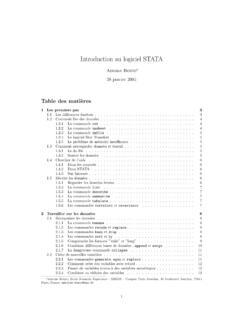Transcription of Lecture 1: Introduction to Public Economics
1 Lecture 1: Introduction toPublic EconomicsAntoine BozioParis School of Economics (PSE) Ecole des hautes etudes en sciences sociales (EHESS)Master APE and PPDP aris September 20221 / 81 Practical Informations One course, three professors Antoine Bozio Julien Grenet Thomas Piketty Related courses at PSE economic History (Thomas Piketty) Optimal Taxation (St ephane Gauthier) Ageing and Public Policy (Antoine Bozio) How to reach me ? E-mail Office Hours : Thursday, , Campus Jourdan,Office R3-15 Please send an email to make sure I am available2 / 81 Practical Informations Reading list in the syllabus Articles with * are mandatory reading Feed your intellectual curiosity tutorials TA : Claire Leroy 3 sessions, 3 problem sets Evaluation One problem set marked (13of final grade) Exam at the end of term (23of final grade) Material : slides and articles with * Example of past exams on the web site3 / 81 Public EconomicsIn Search of Good GovernmentFigure 1 The Allegory and Effects of Good GovernmentSource :Wikipedia ; Ambrogio Lorenzetti, Effeti del buon governo in citt`a , Palazzo Pubblico, / 81 What is Public Economics ?
2 What s in a name ? Political economy (18th c.) Public finance (19th c.) Public Economics (1960s) Public finance vs Public Economics In the , still Public finance , but very different fromfinances publiques Public Economics is about the Economics of the publicsector (cf. GermanStaatswirtschaft) Aiming to answer two types of questions :(i) How do government policies affect the economy ?(positive approach)(ii) How should government policies be designed to attaincertain objectives ?(normative approach)5 / 81 Historic overview of the field Political Economy in the 18th c. Adam Smith, John Stuart Mill, David Ricardo, Karl Marx,etc.(see Musgrave, 1985) Tariff policy (international trade) Public goods (A. Smith) Taxation (Physiocrats, D. Ricardo) Adam Smith in The Wealth of nations (1776) Canons of taxation 1 Equality2 Certainty3 Convenience ofpayment4 Economy ofcollection6 / 81 National traditions of Public finance German school, Staatswirtschaft Economists more favorable to Public sector, so-called pulpit socialists (Kathedersozialismus) , Werner Sombart, Adolph Wagner, Gustav von Schmoller French school Marginal calculus, Public sector pricing, optimal taxation Engineers working in Public utilities (Ponts, Mines, EDF) , Jules Dupuit, Maurice Allais, Marcel Boiteux (Kolm, 2010)
3 Italian school, Scienza delle Finanze Marginal utility, the State as nexus of , Antonio de Viti de Marco, Maffeo Panteleoni Stockholm school, Stockholmsskolan Macroeconomic stabilisation, welfare , Knut Wicksell, Gunnar Myrdal, Bertil Ohlin, Erik Lindahl7 / 81 Historic overview of the field Welfare Economics Development of Public Economics with Musgrave andSamuelson in the 1950s(see Dreze, 1995) Theoretical progress with mathematical analysis Three branches of government (Musgrave 1959)1 Resource allocation to address market failures2 Income redistribution3 Macroeconomic stabilization Recent developments Split with macroeconomics (in the 1970s) Focus on empirical approaches8 / 81 Why choose Public Economics ? I admit to more than only a scientificmotivation ; intelligent and civilizedconduct of government and thedelineation of its responsibilities are atthe heart of democracy.
4 (..)[It] requires an understanding of the economic relationsinvolved ; and the economist, by aiding in this understanding,may hope to contribute to a better society. Richard toThe Theory of Public Finance. A Study in PublicEconomy(1959)9 / 81 Why choose Public Economics ?1 Relevance Public Economics is about improving economic welfare Public Economics is about good government Public policies affect millions of people2A dynamic academic field At the frontier in applied microeconomics : cf. credibilityrevolution (Angrist and Pischke, 2010) Tight integration of theory and data Large use of big data Strong interactions with other fields : labour, behaviouraleconomics, , macro, / 81 Empirical methods in Public economics1 Quasi-experimental methods Variety of methods : DiD, event-studies, RDD, RKD,bunching, etc.
5 Emphasis on non-parametric graphical techniques : Show me the graph ! 2 Sufficient statistics approach Structural vs reduced-form debate(Rosenzweig and Wolpin,2000) Sufficient statistics : theory is used to derived formulasbased on empirical estimates(Chetty, 2009)3 Big data have transformed empirical research Scanner data on consumer purchases Administrative tax data Administrative social security data11 / 81 Figure 2 Language trends in Public Economics0%10%20%30%40%50%60%70%80%90%10 0%Fraction of WordsYearTaxesEducationTransfersPolitica l EconomyRegulation, Public Goods, etcPoterbaPE DirectorNotes :The graph shows the frequency of words within different topics as a fraction of all words across topics. Thesample comprises all NBER working papers 1975 2018 tagged Public Economics (4676 papers).Source :Kleven (2018), Language trends in Public Economics [see slides].
6 12 / 81 Figure 3 The Rise of Identification0%10%20%30%40%50%60%Fracti on of PapersYearNotes :The graph shows the fraction of papers that mention the word identification in the context of empiricalidentification. The sample comprises all NBER working papers 1975 2018 tagged Public Economics (4676 papers).Source :Kleven (2018), Language trends in Public Economics [see slides].13 / 81 Figure 4 The Rise of Quasi-Experiments0%5%10%15%20%25%Fractio n of PapersYearDiff-in-DiffRegression DiscontinuityBunchingEvent StudyNotes :The graph shows the fraction of papers that refer to each type of quasi-experiment. The sample comprisesall NBER working papers 1975 2018 tagged Public Economics (4676 papers).Source :Kleven (2018), Language trends in Public Economics [see slides].14 / 81 Figure 5 The Rise of Administrative Data0%5%10%15%20%25%30%35%Fraction of PapersYearNotes :The graph shows the fraction of papers that mention the words administrative data in the context ofempirical identification.
7 The sample comprises all NBER working papers 1975 2018 tagged Public Economics (4676papers).Source :Kleven (2018), Language trends in Public Economics [see slides].15 / 81 Figure 6 Use of Survey Data in top Journals, 1980 2010 Source :Chetty and Bruich (2012), Public Economics : Survey datasets refer to micro surveys such as the CPS or SIPP and do not include surveys designed byresearchers for their study. Sample excludes studies whose primary data source is from developing / 81 Figure 7 Use of Admin Data in top Journals, 1980 2010 Source :Chetty and Bruich (2012), Public Economics : Administrative datasets refer to any dataset that was collected without directly surveying individuals ( ,scanner data, stock prices, school district records, social security records). Sample excludes studies whose primarydata source is from developing / 81A broad set of skills required Moral philosophy What is justice ?
8 What is fair ? Institutional knowledge Government policies are complex Details matter economic theory Welfare Economics : micro, macro, IO, etc. Optimal tax theory Empirical methods Reduced form vs structural approaches Ex-ante vs ex-post policy evaluations18 / 81 Course outline1 Introduction to Public Economics [A. Bozio]2 Tools of welfare analysis [J. Grenet]3 Externalities [J. Grenet]4 Public good [J. Grenet]5 Commodity taxation [A. Bozio]6 Labour income taxation [A. Bozio]7 Labour income taxation [A. Bozio]8 Preferences aggregation and intertemporal justice [ ]9 Wealth and property taxation [T. Piketty]10 Optimal taxation of capital [T. Piketty]11 Corporate taxation [A. Bozio]12 Social insurance [J. Grenet]19 / 81 Lecture outlineI. Public spending and taxationII. Normative theories of social justiceIII.
9 Rationales of government interventions20 / 81I. Public spending and taxation1 Growth of the State2 Background facts on Public spending3 Background facts on Public taxation4 Theories aiming at explaining the growth of the State21 / 81 Growth of the State Minimal state in the 19thc. Public spending 10% of GDP Almost no social spending Huge growth in the 20thc. 1920s : States doubled in size compared to 19th c. Strong acceleration during the period 1960 1980 See LindertGrowing Public (2004) for detaileddocumentation about this expansion High level today, with some heterogeneity Public spending today 45% of GDP Heterogeneity in the total level : France, Sweden 55% GDP and Japan 40% GDP22 / 81 Figure 8 Public Spending (% of GDP), 1870 20140%10%20%30%40%50%60%70%80%1860188019 00192019401960198020002020 SwedenFranceGermanyUnited KingdomUnited StatesJapanSource :Bozio and Grenet (2010), figure and Schuknecht (2000) for period 1870-1960 ; OECD Historical Statistics (2001) for period 1968-1988.
10 For period / 81 Figure 9 Social Spending (% of GDP), 1880 20160%5%10%15%20%25%30%35%18801900192019 401960198020002020 FranceGermanyJapanSwedenUnited KingdomUnited StatesDenmarkSource :Lindert (2004) for period 1880-1970 ; OECD Social Expenditures for period / 81 The rise of the social State Emergence of welfare states Bismarck s social insurances in Germany (1883) Beveridge National insurance plan (1941) in the UK S ecurit e socialein France (1945) Variations in welfare states Different models of welfare states(Esping-Andersen, 1990) Social insurance vs means-tested benefits Public social insurance spending explains a large part ofoverall differences in Public spending (notably pensionspending)25 / 81 Larger view of Public interventions Narrow focus of Public Economics Public spending and taxation Overlooked aspects of Government Political rights, civil rights, political regimes Property regimes, Workers rights, Labour law Monetary regimes Where is the State biggest ?


